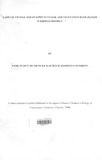Land use change and its effects on soil and vegetation degradation in Kibwezi District.
Abstract
Land degradation is caused by removal of vegetation cover and subsequent fertility loss. Frequent
assessment of land use changes and their effects on soil and vegetation in ranches is critical to their
conservation. This study, carried out in four selected ranches in Kibwezi District is important because
previous studies in the area have mainly dwelt on soil erosion and no research has been done on
effects of land use changes on soil quality in terms of organic carbon, total nitrogen and vegetation
cover. The objectives of the study were to determine plant species density and diversity; assess soil
quality in terms of total nitrogen content and organic carbon; and determine the relationship between
abundance of plant species and soil characteristics to ascertain levels of soil and vegetation
degradation. This study was intended to shed light on the impacts of land use changes on the
productivity of rangelands in relation to soil quality and vegetation cover.
Transects measuring 200m traversing cultivated farms and grazing areas were established within the
study sites namely Kiu, Ngaamba, Ulu/Aimi and Konza South ranches. Data was collected in three
seasons. Phase one and three during the wet seasons and phase two in the dry season. Trees and
herbaceous plants species were sampled using the Point Centered Quarter method (PCQ) and 1m2
quadrat respectively. Where shrubs were encountered a 5m xl Om quadrat was used. Soil samples were
collected from a monoIith measuring 10cm x 10cm x 30cm at the centre of each 1m2 quadrat.
Total nitrogen was determined using the Wet Digestion method, Organic carbon using Walkley-Black
method and soil texture by Bouyoucos or hydrometer method. Soil moisture was determined using
Anderson and Ingram method while for soil pH 50ml of deionised water was added to 20 ± O.Ig soil
measured on 2.5: 1water to soil suspension.
A total of five species belonging to four families were recorded during the study. Acacia tortilis had
the highest density across seasons (291.4 trees per hectare) and Lannea schwanfurthii (8.25 trees per
hectare) the least. Diversity indices of trees revealed a significant difference in species richness among
the ranches (F [3, 16] = 5.066, P <0.05) with Konza ranch recording the highest diversity index.
ANOV A test revealed a significant difference in the mean abundance of tree stumps among the
ranches (F [3, 6] = 159.458, P <0.05) where Ulu/ Aimi ranch contributed the highest number of tree
stumps in the study area while Ngaamba had the least. ANOV A test revealed a significant difference
in the mean abundance of shrubs species among the ranches (F [3, 126] = 0.993, P <O.OS) with Ulu ranch
recording the least abundance. There was also a significant difference in the mean abundance of grass
species among the ranches (F [3, 169] = 21.S04, P <O.OS).
Results of ANOY A test revealed significant differences in the mean abundance of forbs species
among the ranches (F [3,214] = S.792, P <O.OS). ANOYA test results for soil analysis revealed no
significant differences between the ranches in terms of both total nitrogen (F [3,5] =3.262, p>O.OS) and
organic carbon (F [3,5] =1.763, p>O.OS) in the soil. The broad ratings of carbon and nitrogen confirmed
that the four ranches had very low levels of both organic carbon and total nitrogen.
Both grass and forbs species had no significant correlations with pH (r = 0.24, p>O.OS and 0.2, p>O.OS
respectively), while shrubs showed significant correlation (r = -0.4, p<O.OS). Shrubs (r= 0.61, p>O.OS;
0.42, p>O.OS and 0.06, p>O.OS respectively) and forbs (r = -0.02, p>O.OS; -0.18, p>O.OS and -0.17,
p>O.OS respectively) had no significant correlation with organic carbon, total nitrogen and moisture
respectively while grass had a significant correlation with moisture (-0.S3, p<O.OS) but no significant
correlation with organic carbon (r= -0.3S, p>O.OS) and total nitrogen (-0.2S, p>O.OS).
The results of the study showed that there was a decline in plant species diversity, this probably being
as a result of increased human activities in the ranches. It is therefore important to sensitize farmers on
the need to plant and maintain trees as they play an important role in recycling leached nutrients and
tapping new nutrient stocks from deeper soil layers. Cover crops should also be planted on the terraces
to increase vegetation cover.
Citation
Master of Science in Biology of ConservationSponsorhip
University of NairobiPublisher
University of Nairobi School of Biological Sciences

